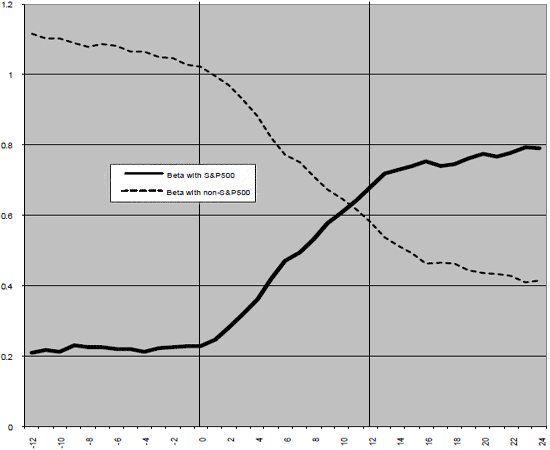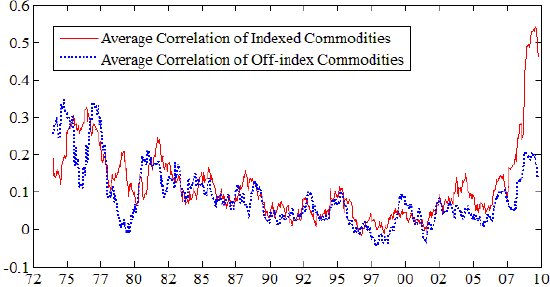What are the implications for investors of a trend toward strategic and tactical allocation to index proxies (exchange-traded funds and derivatives) rather than individual securities? The July 2010 paper entitled “On the Economic Consequences of Index-Linked Investing” by Jeffrey Wurgler provides an overview of the effects of index-linked investing on stock prices, risk-return trade-offs, investor portfolio allocation decisions and fund manager skill assessments. The September 2010 paper entitled “Index Investment and Financialization of Commodities” by Ke Tang and Wei Xiong investigates the effects of increased investing during the last decade in commodity indexes. The October 2010 paper entitled “The Financialization of Commodity Futures Markets or: How I Learned to Stop Worrying and Love the Index Funds” by Scott Irwin and Dwight Sanders surveys research on the impact of commodity index fund growth on commodity price behavior. Using results of prior research and recent data on indexation investment levels, index returns and component asset returns, these papers find that:
Key points from “On the Economic Consequences of Index-Linked Investing” are:
- About $8 trillion is easily identified as invested in equity index proxies and other funds benchmarked to indexes. New stock market phenomena emerge from the finite ability of stock markets to absorb this demand.
- Index fund managers currently must quickly acquire about 8.7% of stocks newly added to the S&P 500 Index, increasing their market values by roughly 9% on average.
- Stocks newly added to the S&P 500 Index quickly begins to track other index members more closely and the rest of the market less closely (see the first chart below).
- Because index investors are less interested than active investors in relative valuations among index components. Strong demand for index proxies can therefore drive average valuations of these components to persistently elevated valuations, thereby disrupting risk-return valuation metrics.
- Index trading strategies may create low-frequency feedback loops that elevate component valuations (index momentum bubbles) and high-frequency feedback loops that elevate volatility (flash crashes).
The following chart, taken from the paper, shows the average 12-month rolling beta of 153 stocks newly added to the S&P 500 Index between 1988 and 2000 relative to other S&P 500 stocks and relative to non-S&P 500 stocks. The horizontal axis is in months, with month zero the month during which the stocks join the index. Results indicate that returns of stocks joining the index quickly synchronize with those in the index as if they had “joined a new school of fish.”

Key points from “Index Investment and Financialization of Commodities” are:
- Since the early 2000s, price movements of different commodity futures in the U.S. are increasingly synchronized as financial motivations such as diversification displace supply and demand. Specifically, prices of non-energy commodities are increasingly correlated with oil prices.
- This effect is significantly more pronounced for commodities in the Goldman Sachs Commodity Index (GSCI) and the Dow Jones UBS Commodity Index (DJ-UBS). (See the chart below.)
- Return correlations of commodities with stocks and the U.S. dollar also significantly increase in recent years.
- Synchronization drives spillover of price volatility across commodities and asset classes.
The following chart, taken from the paper, shows the average one-year rolling return correlations of indexed (GSCI and DJ-UBS) and off-index commodities from 1973 to 2009. The strong increase in average correlation among indexed commodities to 0.5 in 2009 contrasts with the mild increase for off-index commodities. While indexation is a likely culprit for recent synchronization, inflation and inflation volatility arguably drive the relatively high average correlations of both indexed and off-index commodities in the 1970s and early 1980s.

Key points from “The Financialization of Commodity Futures Markets or: How I Learned to Stop Worrying and Love the Index Funds” are:
- Investment in commodity index funds grew dramatically to hundreds of billions of dollars over the last decade.
- Reasonable criticisms limit confidence in the conclusions of studies finding that this growth substantially distorts commodity futures prices (including “Index Investment and Financialization of Commodities”).
- While correlation between stock and commodity index returns has been at historically high levels since late 2008, robust studies fail to find compelling evidence of a significant relationship between growth of commodity index funds and commodity futures price behavior. The cause of high correlation may lie elsewhere.
- The weight of evidence tilts in favor of belief that growth in commodity index funds has not distorted commodity futures price behavior.
What might trends toward financial synchronization mean for investors? Possibilities are:
- Diversification/hedging strategies for indexed assets and asset classes based on “old” correlation data may not work as expected.
- Long-term and short-term volatility may be historically high, perhaps triggering regulation.
- Both fundamental valuation and technical analysis based on “old” asset discriminator data may not work as expected on indexed assets. Fundamental valuation may work best for non-indexed assets. (See “The Decline of Stock Picking?” for further discussion.)
- Macroeconomic analysis may be ascendant as a driver of synchronized volatility.
In summary, evidence from formal research is mixed on whether indexation trends tend to elevate financial and macroeconomic considerations and suppress asset fundamentals as asset price and market drivers.